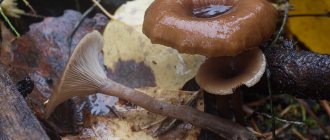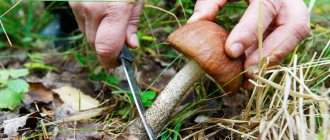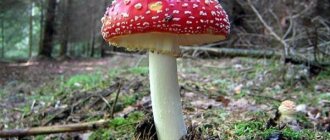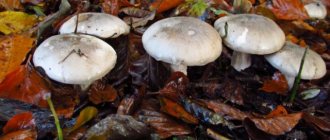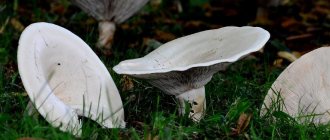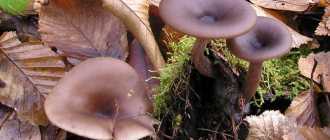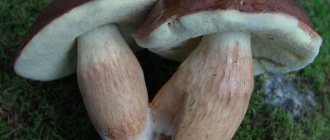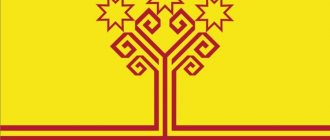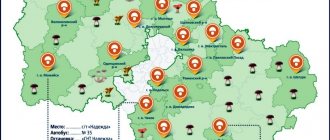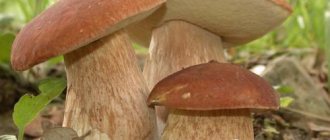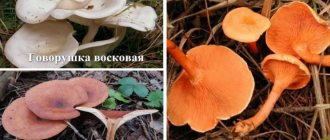Description of the mushroom
There are more than 250 species of these mushrooms. They all have a cap and a stalk, but their shape, size and color depend on the type of mushroom. Most talkers are classified as little-known edible and conditionally edible mushrooms; in terms of nutritional value they are included in category 4. Before use, they must be boiled in water, the first broth is drained.
Cap part of the mushroom
It does not grow to large sizes, reaching an average of 3-6 cm in diameter. In young mushrooms it has the shape of a hemisphere, but with age it levels out and takes on a depressed shape.
The surface is smooth and dry under normal climatic conditions, but during frequent rains it can be covered with a slimy film. Sometimes on the upper part you can see spots that look like mold - these are the remains of mycelium. The color ranges from white to pink-brown and even ocher, depending on the species. The color tends to lighten at the edges of the cap.
Records
The color of the plates also varies. They descend along the stem, and can be frequent or rare. They produce white spore powder.
Leg
The height and diameter of this part of the fruiting body of the mushroom also depends on the variety, but on average the height is 6-8 cm and the diameter is 0.5-3 cm.
Pulp
White in color, dense in young mushrooms and loose in older mushrooms.
Spore powder
Pure white or creamy-whitish color.
Is it possible to be poisoned by a false chanterelle?
Information about the toxicity and edibility of cocos has always been quite contradictory. Previously, it was unconditionally classified as a poisonous mushroom and was considered inedible. Recently, this species has been classified as conditionally edible with low nutritional value and is not recommended for use.
In England, where orange talker is eaten, there have been reports of cases of hallucinogenic effects after eating it. In France it is collected everywhere. In Russia, false chanterelle is considered conditionally edible, requiring preliminary processing.
But remember, all mushrooms tend to accumulate pollutants and heavy metals. Therefore, it is impossible to collect Hygrophoropsis near industrial enterprises and highways, as this can lead to food poisoning.
Types of talkers
There are a huge variety of talkers, it is impossible to list them all; of the most famous types, only the most popular can be distinguished.
Curled or red
The most famous representative of this family. It often grows in large colonies in different forests. The reddish cap grows up to 20 cm. It changes shape as it grows - in young talkers it is convex, in more mature mushrooms it is funnel-shaped, the edges are slightly lowered and curl down. The skin on the cap is smooth, yellowish-brown in color, but fades with age and becomes fawn in color with rusty spots. The yellowish leg is 15 cm long and no more than 3 cm thick. The shape is cylindrical, thickened towards the bottom.
They grow in Germany, Poland, France, Spain, Italy, Russia, Belarus and other countries of the Northern Hemisphere with a temperate climate. It bears fruit actively from the first days of July, and the last mushrooms can be found even in October. A favorite place is along the edges of paths, on forest edges and grassy meadows, in the depths of deciduous, coniferous or mixed forests on a litter of fallen leaves or mosses. They grow in arched clumps.
Orange or cocoshka
Another name is false chanterelle. There is a resemblance to a real chanterelle, but differs in its thin and dense flesh and bright color.
The mushroom cap is small, 2-5 cm in diameter; initially it has a convex shape, but over time it becomes flat, with outstretched edges, slightly curved at the ends. The color is orange-ocher, fading to pale yellow, but the middle remains bright yellow and the edges become almost white.
The leg is cylindrical, length - up to 5 cm, diameter about 0.5 cm, yellow-orange, brighter than the cap.
It bears fruit from the beginning of August to the end of October, it can be found in coniferous and mixed forests, and can grow either singly or in groups.
Only the caps of young cocos are eaten, since their legs are tough, and old caps become tough and tasteless.
Gigantic
Record holder among other species for the largest cap and stem. The mushroom is completely white. The cap usually grows up to 15 cm, but it is quite common to see mushrooms with 30 cm caps. At first it is convex, then it takes the shape of a funnel with the edges turned down. The size of the cap does not lag behind the leg. It is 4 cm thick and 8 cm long. The pulp is white and dense, but has practically no taste or aroma.
The giant talker can form “witch circles,” although it is believed that mainly poisonous representatives of the mushroom kingdom grow this way. The mycelium growing in the ground spreads evenly in all directions, which is why it occupies the area in a ring. Therefore, mushrooms grow along the border of the mycelium, located in a circle.
It grows in forest glades in North America, Europe and Russia. It bears fruit from late August to October, and can sometimes be found even in October.
Goblet
The most common in Russia. It settles on rotten wood or forest floors. Mushroom pickers go to the forest for it in August - September. The gray-brown cap is shaped like a cup or glass, with a diameter of 3–8 cm. The stem is very thin, reaches a maximum thickness of 0.6 cm, and a length of 10 cm. The pulp is watery, grayish-brown in color.
Voronchataya
It grows both singly and in groups in forests, meadows and pastures. The mushroom harvest occurs between July and October. The hat is small (10 cm in diameter). Initially, it is convex with a tubercle in the middle and curled edges. Then the mushroom gradually unfolds and forms a deep funnel, the edges of which are curved outward.
The cap is thin, light yellow or reddish in color. The leg, which has the same color as the cap, is of medium length and does not exceed 8 cm in length. At the base there is a slight thickening with white hairs. The pulp also has almond notes, is white, and not dense. The plates of the hymenophore are located frequently and strongly descend onto the stalk.
The species is widespread in the European territory of Russia, Western Siberia, the North Caucasus, as well as most European countries.
Smoky
The mushroom is found in spruce and pine forests from late summer to November. It grows in groups. The hat resembles a gray pillow. Young mushrooms may have a gray-white coating on the surface, which is easily removed. The leg grows up to 12 cm in length, 2-3 cm in diameter. There is a slight thickening at the base.
The pulp is white, has a floral-fruity aroma, fleshy, soft in young mushrooms, more fibrous and tough in mature ones.
Although the smoky talker is a conditionally edible mushroom, its consumption can cause serious harm to the gastrointestinal tract, since the mushroom contains nebularin, a cytotoxic substance.
Smoky white
Slightly different from its brother - the smoky talker. The cap of representatives of this species reaches a diameter of up to 20 cm, but usually no more than 15 cm. In young mushrooms it has the shape of a hemisphere, convex with a folded edge, over time it becomes convex-prostrate, fleshy, thick, the color is yellowish-whitish or dirty -white, can be gray in dry weather.
The leg is thick, can grow up to 8 cm in length, 1-3 cm in diameter, club-shaped, expanding over time towards the base, grayish, almost white.
The pulp is fleshy, dense, and has a characteristic fruity aroma.
It bears fruit from early September to November, but the peak occurs in September. Found in coniferous and mixed forests.
This species has some similarities with the poisonous White Row, which can be distinguished by its unpleasant aroma.
Club-shaped
An unusual mushroom that looks like an exotic jug. It settles in forests on coniferous forest floors. The convex dark gray cap straightens as the mushroom grows, diameter is 4-8 cm. The stem at the base is strongly swollen, and resembles an inverted club, length is 3-6 cm.
The pulp is ash-gray in color, but tastes very pleasant and has a pronounced mushroom aroma. Mushrooms grow in families, often fused with legs. It grows in coniferous forests from July to October, sometimes found in deciduous and mixed forests.
Fragrant
Refers to conditionally edible mushrooms, used in pickled or boiled form (cook for at least 10 minutes). It grows in coniferous and mixed forests, but is quite rare. The period of active fruiting is from the first half of September to the first half of October. The cap part of the mushroom is small, up to 6 cm in diameter, at first convex in shape, later becoming concave, with a drooping edge, color yellowish-gray or pale ocher. The stem is the same color as the cap, thin, can reach 5 cm in length, and is cylindrical in shape. The pulp is thin, watery, whitish in color.
There is a similarity with the fragrant talker, but differs from it in the yellowish color of the cap.
Fragrant
It is collected very rarely, although it is a very aromatic mushroom that smells like anise. But due to its strange bluish-green color, many mushroom pickers consider it poisonous. The cap is small - does not exceed 7 cm, flat with a tubercle in the middle. It is an unattractive bluish-greenish color, becoming gray-yellow with age.
The cylinder-shaped leg is painted, as is the cap. It reaches 5 cm in length. The plates on the lower surface of the cap part are pale green. The flesh is fleshy, but the color repels mushroom pickers - it is pale gray with a green tint. Even if you boil the mushrooms, the color will not change.
Abundant fruiting occurs from the first ten days of August to the second half of October. It inhabits deciduous, coniferous or mixed forests of Western Siberia, Central and Eastern Europe, and the European part of the Russian Federation.
Winter
The mushroom grows in the European part of the post-Soviet space; it can also be found in the Caucasus, the Far East, Western Europe, South America and North Africa. Fruiting period is late autumn.
The convex cap reaches 5 cm in diameter, later taking on a depressed shape. The edges are thin and slightly sinuous, the color of the cap is smoky or olive-brown. The cylindrical leg reaches a height of 4 cm, the color matches the color of the cap.
Snezhnaya
Some mushroom pickers claim that the snow talker is an edible mushroom, but officially it belongs to the category of conditionally edible.
The diameter of the cap part is up to 4 cm, initially it is convex, with curved edges, over time it becomes depressed, smooth, the color is gray-brownish, it can be gray-brown, the middle is darker than the edges. The leg is thin, up to 4 cm in length, cylindrical, light in color.
The flesh of the mushroom is dense, hard in the stem, and may be odorless or with a faint cucumber tint.
The fruiting period is short - from the beginning to the end of May, lives in light spruce or coniferous forests, and is not found every year.
Where do talker mushrooms grow?
The growing area of talkers is very extensive and includes all countries of the Northern Hemisphere with a temperate climate. Talker mushrooms grow among meadows, fields and park areas. The genus forms stable mycorrhizae with deciduous or coniferous trees in forests of the European part of Russia, France, Italy, Portugal, Poland, Germany, Denmark, Belarus, Spain and other European countries. Found in Western and Eastern Asia. Populations of talkers have been recorded in Turkey, China, and the Primorsky Territory. Some species grow throughout the North American continent.
What mushrooms can be confused with - poisonous varieties
There are a number of poisonous and deadly varieties of talkers. You need to be able to distinguish them from edible varieties.
Waxy talker
The cap of this mushroom is dirty white, watery circles with a tubercle in the middle are noticeable on its surface, the funnel is not as deep as compared to the funnel-shaped talker, the poisonous mushroom does not have a pleasant smell.
Also, this toxic mushroom should be distinguished from the edible cherry blossom. The hat differs from the pendant in that in the center of it you can see a wide hump-shaped tubercle, the edges are wavy, sometimes even fluffy. The leg is slightly bent, fluffy at the base.
Brown-yellow
The cap body of the mushroom can reach a diameter of 10 cm, but specimens with a cap of 3-6 cm are more common. The shape is convex, with a barely noticeable tubercle and a curved edge. When drying, small wet spots appear, which is a distinctive feature of the fungus. The color is yellowish-brown, yellowish-ocher, reddish, fading to cream, often with rusty spots.
The leg is up to 5 cm long, diameter - 0.5-1 cm, smooth, barely narrowed towards the base, yellow-ocher or pale ocher color.
Fruits from the beginning of July to the end of October, found in coniferous and mixed forests, in groups.
It is similar to an inverted talker, but since both mushrooms are classified as inedible, their distinction is not particularly important.
Talker inverted
The diameter of the mushroom cap can reach 10 cm, initially it is convex, over time it acquires a wide funnel-shaped shape, the color is red, brick-rusty, sometimes with dark rusty spots.
The leg can reach up to 6 cm in length, is rigid, the color matches the color of the cap, a little lighter.
It grows from the beginning of August to the end of October in coniferous forests, groups forming the shape of rings, or growing in a row.
The inverted talker is considered poisonous due to the content of poisons similar to muscarine.
Translucent talker
Unknowing mushroom pickers may confuse it with other representatives of the genus. The cap is round, nutty or ocher in color; after rains, the surface is covered with a mucous film and becomes sticky. The pulp is white, fleshy. The leg is cylindrical, approximately 3.5-4 cm long. Like the cap, it is colored in ocher, brick tones, darkens with age and becomes dark red or bright brick.
It is found in coniferous and deciduous forests, likes to settle on infertile soils, and is distinguished by the fact that it grows in large groups.
Pale or grayish
Externally, young mushrooms of this species are very similar to winter talker. The cap is more lumpy than that of the winter talker; over time, pits appear on it. The diameter reaches a maximum of 5 cm. The leg is hollow, the color is also slightly different from the winter one - at first it is grayish with a whitish coating, then grayish-brownish. The pulp is watery, odorless.
It grows in fallen oak or birch leaves; some specimens are found in mixed and even coniferous forests. It grows alone, while most edible varieties grow in groups.
Whitish talker
Poisonous mushroom containing muscarine. The cap is small, only 1-4 cm in diameter, flat. Its color in the center and along the edges varies, in the middle it is pale red, and at the edges it is pale gray.
Pulp with a deceptively pleasant aroma, reminiscent of the smell of tomato seedling leaves. The leg is light gray in color, with a pinkish tint; towards the base the color becomes gray. Grows in meadows, deciduous, mixed and coniferous forests.
Reddish or furrowed
Deadly poisonous mushroom. The diameter of the cap is small, does not exceed 4 cm. The color can vary, from powdery white to pinkish-brown. Sometimes there is a light powdery coating on the surface, as well as grayish spots. The pulp is fleshy and has a pleasant sweetish smell. The leg is thin and short, cylindrical in shape. In young mushrooms it is fibrous, in old ones it is hollow.
It bears fruit from the second half of July to the beginning of November. You can meet it in forest glades and forest edges, and even in city parks.
Low-smelling talker
The diameter of the cap reaches 6 cm. It is initially convex in shape, but gradually opens up as it develops, becoming flat or funnel-shaped. Color - beige, brown or gray-brown, covered with a waxy coating.
The leg reaches a length of up to 6 cm, cylindrical or flattened, located in the center. The color is slightly lighter than the color of the cap.
Grows in winter in mixed and pine forests from December to January.
Present talker
The cap body of the mushroom reaches 6-10 cm in diameter, initially has a convex shape, with a curved edge and a noticeable tubercle, over time it becomes tuberculate, with a drooping, wavy edge. Color - white or cream.
The leg is quite long, up to 8 cm, cylindrical in shape, becoming hollow with age. Whitish in color in young representatives and grayish-brownish in old mushrooms. The pulp is fleshy, whitish, and has a sharp spicy aroma.
It grows from September to November, likes to settle in birch forests and coniferous forests.
When picking mushrooms, follow the rule: if you are not sure whether a mushroom is edible, then it is better to leave it in place.
Similar species
- The talker is bent.
The species is edible and is not inferior in nutritional value to the funnel-headed talker. Distinctive features are the tucked edge of the cap and the reddish tint of the color of the mushroom, as well as a larger fruiting body.
- The talker is brown-yellow.
Reports of toxicity vary, but the mushroom is definitely inedible. It is distinguished by the folded edge of the cap and brown spots with a rusty tint scattered over the surface of the cap and spore-bearing layer.
- The talker is whitish.
The most dangerous double, since when it fades towards old age it becomes especially similar to the funnel talker. It is distinguished by the white coating on the fruit body and the powdery aroma of the pulp.
1-The speaker is bent. 2-Talker brown-yellow. 3-The talker is whitish.
Poisoning by poisonous species of talkers
Symptoms of poisoning by the toxin muscarine, which is contained in the pulp of poisonous mushrooms, appear within 3 hours. They are expressed as follows:
- gastrointestinal dysfunction, severe nausea, vomiting, diarrhea, cramps in the stomach and intestines are the main symptoms;
- disruptions in the functioning of the cardiovascular system, they are accompanied by a sharp decrease in blood pressure, sinus bradycardia;
- increased sweating;
- increased salivation;
- difficulty breathing, bronchospasms and asthma.
The most dangerous mushroom from the govorushka family is considered to be the waxy govorushka. Its pulp has a deceptively pleasant taste and aroma. Often the symptoms of poisoning do not appear in any way. However, on the fifth day the person dies from acute renal failure.
First aid for poisoning
At the first symptoms of talker poisoning, you need to call an ambulance. The antidote for muscarine is atropine. If possible, an atropine injection is given to prevent the development of poisoning. When this is not possible, then the victim must be laid down before the ambulance arrives.
The patient should not be given any antiemetic drugs or medications for diarrhea - the body must be cleansed of the poison. During poisoning, vomiting occurs spontaneously, this is a symptom. You can independently provoke vomiting by irritating the root of the tongue with your fingers, but you should not drink water for this purpose, as it will enhance the absorption of the poison. It is better to let the patient take activated charcoal or any other sorbent.
If the patient has lost consciousness, you need to lay him on his side to prevent vomit from entering the respiratory tract. During convulsions, make sure that the patient does not hit furniture or surrounding objects. There is no need to give the patient water or do an enema, as this can enhance the absorption of muscarine into the blood and worsen the patient’s condition.
Video
Benefits of mushroom
Talkers are quite useful mushrooms. They have the following qualities:
- increase human immunity;
- have a beneficial effect on the digestive system, as they contain components for enzymes. However, you should not get carried away with mushroom dishes;
- used in the treatment of diseases of the respiratory system and bladder;
- destroy cholesterol plaques;
- antibacterial ointments are prepared from them, which are used to lubricate wounds;
- the caps of young representatives are rich in numerous micro- and macroelements;
- the pulp helps remove accumulated toxins;
- A decoction of talkers is used to relieve the manifestations of tuberculosis.
Use in cooking
Talkers, which have a delicate taste and fruity aroma, are not very popular among chefs. It is worth noting that the caps of young mushrooms are most often eaten. The stems are completely tasteless, and as mushrooms age, they lose their unique flavor. However, young talkers are great for all traditional dishes. They can be fried, boiled, salted, stewed, pickled and dried. They are able to add a subtle and delicate aroma to any dish, which is why they like to be added to soups and sauces. However, these mushrooms are not recommended to be added raw to salads. Due to the enzymes they contain, raw mushrooms have a bitter taste.
When planning to prepare dishes from talkers, remember that they significantly fry and boil down, losing almost half their mass in their volume!
How to collect talkers?
Talker mushrooms are not such popular mushrooms, as they have poisonous counterparts. They are mainly collected by experienced mushroom pickers. It is difficult for beginners to distinguish among this large family of edible members.
The most common in Russia are the funnel-shaped and reddish talkers; they can be found in bushes, among trees, and in clearings. They grow in even rows, sometimes forming “witch circles.”
Useful and negative qualities of a talker
These mushrooms contain a large amount of a natural, potent antibiotic - nerabulin. It is used to treat such serious diseases as pulmonary tuberculosis and inflammatory processes of the human respiratory system.
Frequent consumption of them can be the main cause of serious poisoning. A minimal amount of these mushrooms in the diet helps fill the body with useful substances and microelements.
Experienced mushroom pickers advise collecting them no more than once a month. The photo of talker mushrooms shows all the elements that make up an adult.
Is it possible to grow this type of mushroom yourself?
This is an unassuming mushroom. Therefore, they are grown in open ground in an area with young trees. Quite quickly, mushrooms form mycorrhiza with them.
The mycelium is planted in late spring - early summer, when the time of frost has passed. Three holes are dug near each tree - 20 cm deep and 15 cm in diameter. They are filled halfway with soil; you can use universal soil for indoor plants, which you can purchase in the store. The mycelium is distributed evenly over the soil and covered with soil, compacted well. The top of the holes is covered with pine needles, twigs, and leaves. Carefully water the plantings with water.
However, the first harvest will be enjoyed only after a year; the mycelium bears fruit in one place for up to 5 years.
Govorushki is a tasty and healthy mushroom with a strong, pleasant aroma. But due to its poisonous counterparts, it is rarely collected and used for food and stored for future use. In addition, the fungus plays a huge role in the life of the forest, actively participating in the process of humus formation.
0
1
Copy link
Time and place of fruiting
The cocoshka appears from late July to early August (especially en masse) and bears fruit until the first frost. It grows in coniferous or small-leaved forests, in various conditions on open soil and dense litter.
It is found among moss, on rotting remains of trees, often around anthills, most often in small groups. Under favorable climatic conditions, it bears fruit most actively.
Widely distributed throughout the temperate forest zone of Europe and Asia.
How to distinguish from edible relatives
In addition to similar poisonous mushrooms, the talker can be confused with edible representatives of the species. Namely, confused with:
- Winter talker. Its cap is somewhat different, smaller in size, has a convex and slightly depressed shape, and is smoky or olive-brown in color.
- A weak-smelling talker. It is beige or gray-brown in color. Its convex cap, turning into a funnel, reaches 6 cm. Based on the name, its smell is slightly perceptible.
- A giant talker. The name itself says that this is the largest representative of the family. The giant cap grows up to 9-25 cm, white and fawn in color.
What are the benefits and harms
Its pulp contains many useful elements, their effect has a positive effect on humans due to the fact that it:
- Low-calorie product that reduces excess weight.
- Increases metabolic processes, rids the body of toxins, reduces cholesterol.
- Has antibacterial properties.
- Has a beneficial effect on blood composition.
- Affects the rejuvenation of the human body.
However, abuse of the product provokes various disorders of the gastrointestinal tract, which leads to the appearance or exacerbation of pancreatitis.
general characteristics
Talker mushrooms are a genus that combines many species of edible and poisonous mushrooms. They are distinguished from others by frequent thin plates that descend to a greater or lesser extent on the stem. Talker mushrooms can be found in the forest under the leaves. They form so-called witch rings. There are many edible ones among them, but they are not of high quality. Another interesting property of these mushrooms is their specific smell, which for many people is very unattractive. But there are still brave souls who love to cook talkers. Mushrooms are either fried with onions or salted, adding spices and garlic. You need to collect them very carefully, because many of them are poisonous. They are distinguished by their small size and whitish body color. There are many types of talkers, but the most common are funnel, gray, giant, waxy and whitish.
